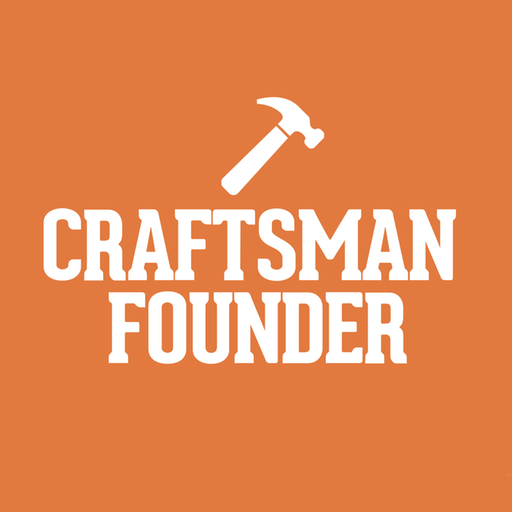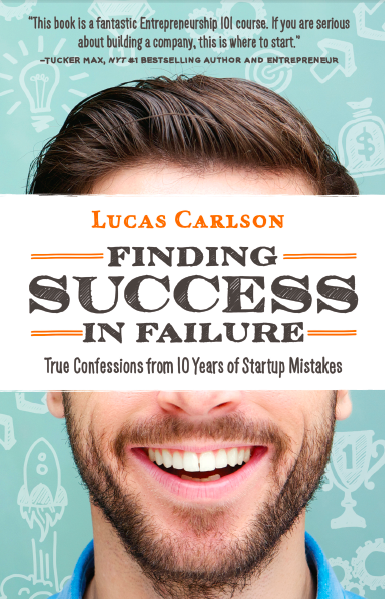Book-in-a-Box Revealed: Behind the Scenes Using Tucker Max’s Book-in-a-Box to Write a Book
I have a confession: I didn’t write my most recent book. Not alone at least. Thanks to an amazing new startup, anyone can be an author, even if you aren’t a good writer.
I want to expose to you the behind-the-scenes magic about how my book was created.
When Tucker Max was on my podcast talking about his new startup Book-in-a-Box, the idea immediately made sense to me. Any entrepreneur or professional should seriously consider having a professionally published book as a way to stand out. You do not need to get a traditional publisher to have a professionally published book as long as you use high quality editors, book cover designers and interior layout people.
Here was the basic process Tucker Max outlined for Book-in-a-Box:
- Create a basic outline
- Record an intensive interview with a professional writer
- Transcript the interview
- Have the professional writer edit the raw interview text into the first draft of a book
- Edit the book
- Get a professional cover design and interior layout
The process made a lot of sense because it was essentially the same way I wrote a programming book a couple years ago, except I had to hire the professional writer and transcription service myself. I ended up using a traditional publisher (O’Reilly) for their book cover, interior layout and distribution, but you do not need a traditional publisher if you don’t want one.
So I decided to try Tucker Max’s new startup for myself and ended up using Book-in-a-Box to write Finding Success in Failure. Along the way, I kept copies of recordings and early drafts of the book so that I could share them with you.
1. The Outline
Most clients of Book-in-a-Box are guided through a process to create an outline from scratch, but I had been wanting to write this book for a while, so I already had an outline in mind. Here is what I actually submitted to Book-in-a-Box. This turned into about 150 printed pages which was about 30 pages per section.
Introduction
Chapter 1: Picking Your Startup Idea
1.1 Why are you starting this company?
1.2 Who is your target customer?
1.3 What is their hair on fire problem?
1.4 Do they have a even bigger problem?
1.5 What kind of startup do you want to be?
1.6 What are your core values?
1.7 What are your strengths and weaknesses?
Chapter 2: The Logistics of Starting a Business
2.1 Have Hard Conversations Right Now
2.2 Pick a Name
2.3 Pick a Business Structure
2.4 Open a Bank Account
2.5 Setup QuickBooks and Evernote
2.6 Create a Landing Page
2.7 Create a Blog and an Email List
2.8 Write
2.9 Talk to a Lawyer
Chapter 3: Things I Wish Someone Had Told Me Earlier
3.1 Your Startup is a Reflection of You
3.2 Never Violate Your Core Values
3.3 You Are Not Your Thoughts
3.4 Your Product is Not Your Company
3.5 You Don't Have to Figure it All Out Up Front
3.6 Startups Are All About Relationships
3.7 Get Ready for the Long-Haul
Chapter 4: 7 Ways to Manage Founder Psychology
4.1 Take Care of Yourself
4.2 Practice Rejection Therapy
4.3 Big Problems vs Urgent Problems
4.4 Deal With The Biggest Urgent Problem First
4.5 Take Time to Reflect and Ask Urgent Questions
4.6 Read Voraciously
4.7 Surround Yourself with Advisors
I ended up re-ordering the chapters, but this was my original plan.
Before we started the interview process, I wrote about a paragraph of notes for each sub-section so my interviewer knew generally what I was thinking. Download the Entire Outline as a Word Doc
2. The Interview
The interview is the main part of the Book-in-a-Box process. It’s where all the content for your book is flushed out. This is turned into a transcript which is then taken by the editors and turned into your first draft. The interviewing process can take 4-8 hours, but I have condensed just 15 minutes out of those hours for you to get a sense for what the interview process is like.
If you want to listen to all 5 hours of my interview for Finding Success in Failure, download it as an MP3.
3. The First Draft
Here is an excerpt of the first draft of Chapter 2 (Logistics, which ended up being Chapter 4 in the Final Draft). You can listen to an excerpt of the real interview that generated this text above in the YouTube video (starts at around 10 minutes into the video).
DIFFICULT CONVERSATIONS WITH YOUR SPOUSE
Sometimes this conversation can be even harder—and scarier—than a tough conversation with your co-founder. One of the mistakes a lot of founders make is keeping their spouses or significant others on the outside. They have all this turmoil going on inside their heart and their mind and their head—they’re scared—but instead of talking about it with their partners they hold it in. You might assume that your partner won’t understand what you’re doing; or that they won’t care. Maybe you are worried about what your partner will say when you tell them about the risks. It can feel much easier to bury your head in the sand or to gloss everything over: “Oh, everything’s going to be great. Funding won’t be a problem,” than it does to pull back the curtain and let them see what’s going on.
The primary aim of these conversations is to honestly inform. You will need to discuss:
– What are the risks and realistic outcomes?
– How much time and money will be invested?
– Will your partner give you honest feedback?The fact is startups can tear a relationship apart, no matter how strong it may be. Honest communication is key, not just in these initial conversations but also throughout the entire process. It is essential that you are able to tell the truth to—and hear the truth from—your partner.
If you want to see the whole first draft, you can Download it as a Word Doc
4. My Edits
I spent a couple months going through every line of the the first draft to make it sound like me. This wasn’t a required step in the Book-in-a-Box process, but it was important to me that it sound like me. After I went through it with my edits, I had about 50 beta readers comb through it as well and help me flush out areas that needed further development. Here is the final draft of the above excerpt:
DIFFICULT CONVERSATIONS WITH YOUR SPOUSE
My wife was six months pregnant when I quit my job to start AppFog. One of the biggest mistakes a lot of founders make is keeping their spouses or significant others on the outside. They have all this turmoil going on inside their heart and their mind and their head—they’re scared—but instead of talking about it with their partners they hold it in.
The reality in my experience was that often my wife was just as scared as I was. If I had told her “Oh, everything’s going to be great. Funding won’t be a problem and I will have a salary again in no time,” not only would she have not believed it, she would have felt alienated and alone with her fears.
The most important part of keeping a relationship together through a startup is staying on the same team. You can’t force your significant other to be on your team, and there will be times when you might feel like they are not on your team. This hurts a lot when it happens. After all, if you are like me, then a big part of why you are taking this risk is to secure your family’s financial future.
Being on the same team isn’t a logical thing based on reasoned thinking. It’s about being on the same emotional team. And that means you have to always be honest about your emotions: good, bad, and ugly. If you aren’t letting your spouse in, how do you expect them to stay on your team?
Maybe you think your significant other won’t understand, or worse that they won’t care. Maybe you are worried about what they will say when you tell them about the risks. It can feel much easier to bury your head in the sand and gloss over everything. Pulling back the curtain and letting them see what’s going on can be scary. But if you didn’t want to do this, you shouldn’t have started a company. This process is brutal. And it’s brutal for them too. Being the spouse of a startup founder is hard. Acknowledge that and show gratitude. They might know it’s for a family legacy, but sometimes that’s not enough.
The primary aim of these conversations is to honestly inform. You will need to discuss:
– How much time and money will (realistically) be invested?
– How much travel and time away from home is acceptable?
– What are the risks and realistic outcomes?
– Will your partner give you honest feedback or be your undying cheerleader?
– Which one would you like them to be?
– Which one are they comfortable being for you?The fact is startups tear many relationships apart, no matter how strong they may be. Honest communication is essential, not just in these initial conversations but also throughout the entire process. It is essential that you are able to tell the truth to—and hear the truth from—your partner.
You can see that I spent a lot of time massaging the first draft to look and sound just the way I wanted it.
5. Cover Designs
The highly talented Erin Tyler created many cover design options for the book. Here are all the different options she offered me.
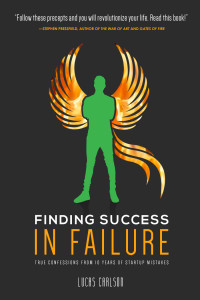
|
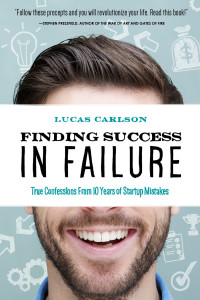
|
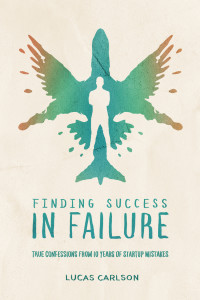
|
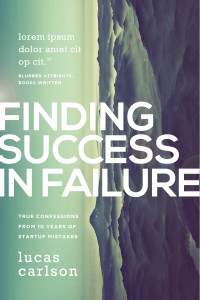
|
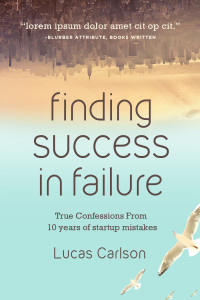
|
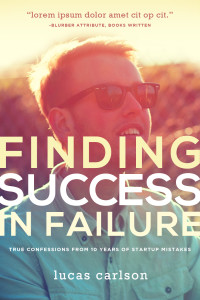
|
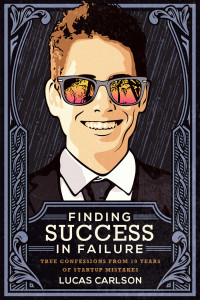
|
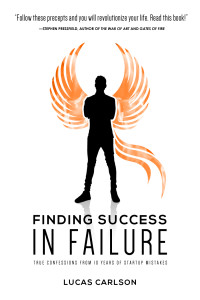
|
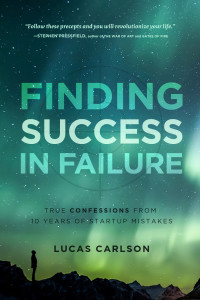
|
6. Audiobook
I first tried to record the audiobook myself. Here is the entire introduction in my own voice.
[soundcloud url=”https://api.soundcloud.com/tracks/198809185″ params=”auto_play=false&hide_related=false&show_comments=true&show_user=true&show_reposts=false&visual=true” width=”100%” height=”450″ iframe=”true” /]But everyone said that I didn’t do a good job, so I hired a professional voice actor. You can listen to his rendition of the introduction by subscribing to the iTunes Podcast or listen to Chapter 1 for free here:
[soundcloud url=”https://api.soundcloud.com/tracks/198813527″ params=”auto_play=false&hide_related=false&show_comments=true&show_user=true&show_reposts=false&visual=true” width=”100%” height=”450″ iframe=”true” /]7. Final Product
In the end, here is the final cover that my mailing list helped me pick:
The Book-in-a-Box folks did all the uploading to Amazon/B&N/etc for me, which was nice not to have to worry about.
Conclusions
So, all said, would I do it again? In a heartbeat.
The entire process went smoothly and quickly. The promise of getting a “Book” in a “Box” is real and it works. The result is a high-quality product that is indistinguishable from any other professionally published book. I want to thank Tucker Max, Zach Obront, Ann Maynard, Erin Tyler, and everyone else who helped make this book possible.
I definitely suggest any entrepreneur or person in business check out Book-in-a-Box and see if it can work for them. Let them know you found out about it through this article and they might even give you a discount.
About the Author
Lucas Carlson
Lucas Carlson is a hands-on consultant, author and entrepreneur. He helps founders discover opportunities for growth, both for their companies and for themselves. He was the CEO and founder of AppFog, a popular startup acquired in 2013 after signing up over 100,000 developers and raising nearly $10M in venture funding from top angels and VCs.
